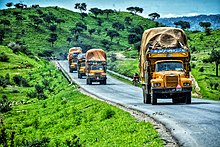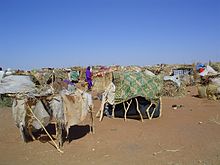Darfur
Darfur Region دار فور | |
|---|---|
Minni Minawi[1] | |
| Area | |
• Total | 493,180 km2 (190,420 sq mi) |
| Population | |
• 2018 estimate | 11,772,520[2][3] |
• Density | 18.7/km2 (48.4/sq mi) |
| Currency | Sudanese pound |
| Time zone | UTC+2:00 (CAT) |
Website Official website | |
Darfur (
The first historical mention of the word Fur occurs in 1664 in the account by J. M. Vansleb, a German traveler, of a visit to Egypt (Petermann (1862-3). Mitteilungen, Erganzungsband II). It is claimed that, like sūdān, fūr means "blacks", and was the name given by the early light-colored Berber sultans of Darfur to the original inhabitants of the country such as the Binga, Banda, etc. As the historic dynasty's physical appearance became more "Africanized" from intermarriage with black wives and concubines, the appearance of the sultans darkened correspondingly and they became known by the appellation of their subjects, Fūr.[6]
Geography
This section needs additional citations for verification. (August 2020) |

Darfur covers an area of 493,180 square kilometers (190,420 sq mi),
There are four main features of its physical geography. The whole eastern half of Darfur is covered with
Remote sensing has detected the imprint of a vast underground lake under Darfur. The potential water deposits are estimated at 49,500 km2 (19,110 sq mi). The lake, during epochs when the region was more humid, would have contained about 2,500 km3 (600 cubic miles) of water.[12] It may have dried up thousands of years ago.[13]
History
This section needs additional citations for verification. (April 2017) |

Most of the region consists of a
The Darfuris were restive under
In 1916, after the British government suspected that the sultan was falling under the influence of the Ottoman government, an expedition was launched from Egypt to capture and annex Darfur into the Anglo-Egyptian Sudan. The colonial government directed financial and administrative resources to the tribes of central Sudan near Khartoum - while the outlying regions such as Darfur remained mostly forgotten and ignored.[4] K. D. D. Henderson was the last British governor of Darfur.[14]
Under Sudanese rule




A pattern of skewed
Nearly two-thirds of the population continues to struggle to survive in remote villages. Virtually no foreigners visit the region because of the fear of kidnapping, and only some non-governmental organizations continue to provide long-term grass-roots assistance. As of 2015[update] the United Nations is in discussion with the Government of Sudan over the withdrawal of
During the existence of the Calais Jungle refugee camp, Darfur was listed as a major source of the camp's inhabitants.[21]
Peace process
Darfur Peace Agreement (also known as Abuja Agreement)
| War in Darfur |
|---|
 |
|
| Combatants |
| Other articles |
|
The
Doha Agreement
In December 2010, representatives of the Liberation and Justice Movement, an umbrella organisation of ten rebel groups, formed in February of that year,[22] started a fresh round of talks with the Sudanese Government in Doha, Qatar. A new rebel group, the Sudanese Alliance Resistance Forces in Darfur, was formed and the Justice and Equality Movement planned further talks.[23] The talks ended on December 19 without a new peace agreement, but participants agreed on basic principles, including a regional authority and a referendum on autonomy for Darfur. The possibility of a Darfuri Vice-President was also discussed.[24][25]
In January 2011, the leader of the Liberation and Justice Movement, Dr. Tijani Sese, stated that the movement had accepted the core proposals of the Darfur peace document proposed by the joint-mediators in Doha; the proposals included a $300,000,000 compensation package for victims of atrocities in Darfur and special courts to conduct trials of persons accused of human-rights violations. Proposals for a new Darfur Regional Authority were also included; this authority would have an executive council of 18 ministers and would remain in place for five years. The current three Darfur states and state governments would also continue to exist during this period.[26][27] In February 2011 the Sudanese Government rejected the idea of a single region headed by a vice-president from the region.[28]
On 29 January, the leaders of the Liberation and Justice Movement and the Justice and Equality Movement issued a joint statement affirming their commitment to the Doha negotiations and agreement to attend the Doha forum on 5 February. The Sudanese government had not yet agreed to attend the forum on that date and instead favoured an internal peace process without the involvement of rebel groups.[29] Later in February, the Sudanese Government agreed to return to the Doha peace forum with a view to complete a new peace agreement by the end of that month.[30] On 25 February, both the Liberation and Justice Movement and the Justice and Equality Movement announced that they had rejected the peace document proposed by the mediators in Doha. The main sticking points were the issues of a Darfuri vice-president and compensation for victims. The Sudanese government had not commented on the peace document.[31]
At the Doha Peace Forum in June, the Joint Mediators proposed a new
2020 peace agreement (Juba Agreement)
This section needs to be updated. (February 2024) |
A comprehensive peace agreement was signed on 31 August 2020 in Juba, South Sudan, between the Sudanese authorities and rebel factions to end armed hostilities.[35]
However, further tribal clashes have continued during 2021.
Languages
Languages of Darfur include
.Other than Fur, the following languages are spoken in Darfur according to Ethnologue.[36]
|
|
Government
The region is divided into five
Demographics and economy
In 2008, Darfur's population was 7.5 million.[40] This in an increase by nearly six times from 1973 (1.3 million).[40] 52% are aged 16 years or younger.[40]
Darfur's budget was US$286 million in 2008.[40]
See also
References
- ^ a b "Minni Minawi to be inaugurated today as Governor of Darfur". 10 August 2021.
- ^ "City Population in Sudan". Retrieved 6 September 2023.
- ^ "Sub-national Population Projections of Sudan and Age-Sex Composition" (PDF). Archived from the original (PDF) on 2017-03-12. Retrieved 2023-06-09.
- ^ ISBN 978-0-300-16273-8
- ^ Veronika Danielová, "Darfur Crisis of 2003: Analysis of the Darfur Conflict from the Times of First Clashes to the Present Day." Ethnologia Actualis 1.14 (2014): 37-59.
- ^ a b Arkell, A.J. (1955). A history of the Sudan from the earliest times to 1821. London: University of London the Athlone Press. P.214.
- ^ "Sudan's Geography". Globaldreamers.org. Archived from the original on 2011-10-05. Retrieved 2010-07-13.
- ^ R. S. O'Fahey (2004-05-15). "Darfur: A complex ethnic reality with a long history". The New York Times. Retrieved 2013-01-19.
- ^ "Congressional Reps Give Update on Troubled Darfur Region of Sudan". Pbs.org. 2005-02-17. Archived from the original on 2014-01-19. Retrieved 2010-07-13.
- ^ "Quick guide: Darfur - BBC News, 2006-09-06". BBC News. 2006-09-06. Retrieved 2010-07-13.
- ^ "Africa Ultra-Prominences". Peaklist.org. 2007-05-10. Retrieved 2010-07-13.
- ^ Tanzina Vega, "Underground lake may bring Darfur peace: scientist", Reuters, July 18, 2007
- ^ Ancient Darfur lake 'is dried up', BBC, July 20, 2007
- ^ Dally, M. W. (2010). Darfur's sorrow: the forgotten history of a humanitarian disaster. p. 173.
- ^ Roland Marchal, "Chad/Darfur: how two crises merge." Review of African Political Economy 33.109 (2006): 467-482. online
- ^ a b Un.org
- ^ Mayroz, E. (2019). "Reluctant Interveners: America's Failed Responses to Genocide from Bosnia to Darfur". Genocide Studies and Prevention. Rutgers University Press. Retrieved 26 October 2020.
- ISBN 978-0-300-16273-8
- ^ Un.org
- ^ Brendan Bromwich, and Margie Buchanan-Smith. "Preparing for peace: An analysis of Darfur, Sudan." in Carl Bruch, Carroll Muffett, and Sandra S. Nichols, eds. Governance, Natural Resources and Post-Conflict Peacebuilding (Routledge, 2016). 183-206.
- ^ "Calais 'Jungle': Migrants hit dead end in journey to UK".
.. among those fleeing Darfur, Afghanistan, Syria, Iraq, Eritrea and other zones of conflict or poverty.
- ^ "EXCLUSIVE: Darfur new rebel group announces formation of its structure - Sudan Tribune: Plural news and views on Sudan". Sudan Tribune. Archived from the original on 2013-08-09. Retrieved 2011-09-05.
- ^ "Sudan Peace Watch-December 21, 2010 | Enough". Enoughproject.org. 2010-12-21. Retrieved 2011-09-05.
- ^ "Sudanese government, LJM rebels to sign a peace accord on 19 December - Sudan Tribune: Plural news and views on Sudan". Sudan Tribune. Archived from the original on 2013-08-09. Retrieved 2011-09-05.
- ^ "Mediators propose Darfur Authority, announce major diplomatic effort | Radio Dabanga". 195.190.28.213. Archived from the original on 2011-01-13. Retrieved 2011-09-05.
- ^ "DOHA: Darfur peace proposals accepted by LJM rebel coalition | Radio Dabanga". 195.190.28.213. 2011-07-09. Archived from the original on 2011-01-13. Retrieved 2011-09-05.
- ^ "Alliance of rebel factions agrees to Darfur peace deal". Monsters and Critics. 2011-01-03. Archived from the original on 2011-12-27. Retrieved 2011-09-05.
- ^ "Sudan Human Rights Information Gateway (SHRIG) - Office of VP must meet National standards, says El Haj Adam". SHRIG. 2011-02-07. Archived from the original on 2012-01-27. Retrieved 2011-09-05.
- ^ Stephen Kinzer (2010-01-24). "End human rights imperialism now". Sudanjem.com. Archived from the original on 2018-12-06. Retrieved 2011-09-05.
- ^ "Sudan government to return chief negotiator to Doha | Radio Dabanga". 195.190.28.213. Archived from the original on 2012-07-07. Retrieved 2011-09-05.
- ^ "Darfur movements reject Doha peace proposal | Radio dabanga". 195.190.28.213. Archived from the original on 2012-07-11. Retrieved 2011-09-05.
- ^ "Under peace deal, Sudan would halt prep for Darfur Referendum". Radio Dabanga. Retrieved 2011-09-05.
- ^ "Sudantribune.com" (PDF). Archived from the original (PDF) on 2016-03-03. Retrieved 2011-06-05.
- ^ "Darfur peace agreement to be signed on 14 July - Sudan Tribune: Plural news and views on Sudan". Sudan Tribune. Archived from the original on 2021-03-03. Retrieved 2011-09-05.
- ^ "Sudan signs peace deal with rebel groups from Darfur". Al Jazeera. 31 August 2020.
- ^ Languages of Sudan. Ethnologue, 22nd edition.
- ^ a b "Sudan Tribune". Sudan Tribune. Archived from the original on 2019-02-04. Retrieved 2010-07-13.
- ^ "Darfur referendum: 'States option' wins by a landslide". 23 April 2016.
- ^ "Darfur votes for five-state status quo: Referendum chief".
- ^ a b c d "Beyond Emergency Relief: Longer-term trends and priorities for UN agencies in Darfur" (PDF). United Nations Environment Programme. 30 September 2010. Archived from the original (PDF) on 2018-04-26. Retrieved 11 January 2014.
Bibliography
- Arkell, A. J., "A History of Darfur. Part II: The Tunjur etc", Sudan Notes and Records, 32, 2 (1951), 207–238.
- Asher, M.J.,"In Search of the Forty Days Road" Penguin. 1984
- Daly, M.W., Darfur's Sorrow: A History of Destruction and Genocide, Cambridge 2010.
- Elliesie, Hatem, "Sudan under the Constraints of (International) Human Rights Law and Humanitarian Law: The Case of Darfur", in Hatem Elliesie (ed.), Islam and Human Rights / al-islam wa-huquq al-insan, Frankfurt, Berlin, Bern, Bruxelles, New York, Oxford, Vienna 2010, pp. 193–217 ISBN 978-3-631-57848-3
- Elliesie, Hatem et al., "Different Approaches to Genocide Trials under National Jurisdiction on the African Continent: The Rwandan, Ethiopian and Sudanese Cases", in Recht in Afrika, Cologne 2009, 12/1, pp. 21–67. ISBN 978-3-89645-804-9
- Foerstel, K. "Crisis in Darfur" CQ Global Researcher (2008). 2, 243-270. online
- Herr, Alexis, Darfur Genocide: The Essential Reference Guide (2020) excerpt
- Johnson, Douglas H. The Root Causes of Sudan's Civil Wars (Indiana UP, 2003), ISBN 0-253-21584-6
- Kiernan, Ben. Blood and Soil: A World History of Genocide and Extermination from Sparta to Darfur (2009) excerpt
- O'Fahey, R. S., The Darfur Sultanate: A History, London 2008.
- Young, Osman, Abusin, Asher, Egemi "Livelihoods, Power, and Choice: The Vulnerability of the Northern Rizaygat, Darfur, Sudan" Feinstein Centre for Marginalized Peoples. Tufts University January 2009


